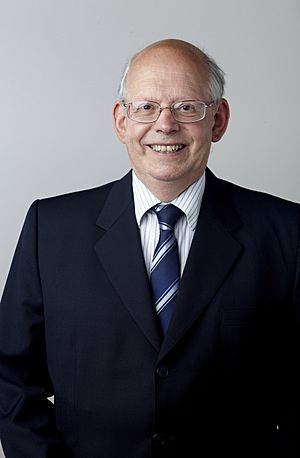Richard Edwin Hills facts for kids
Quick facts for kids
Richard Hills
|
|
|---|---|

Hills in 2014
|
|
| Born |
Richard Edwin Hills
30 September 1945 UK
|
| Died | 5 June 2022 (aged 76) UK
|
| Education | Bedford School |
| Alma mater | |
| Awards | Jackson-Gwilt Medal (1989) |
| Scientific career | |
| Fields | Astronomy |
| Institutions | University of Cambridge |
| Thesis | Interferometric Observations of Radio-Emission from Galactic Water Vapour (1973) |
Richard Edwin Hills (born September 30, 1945 – died June 5, 2022) was a British astronomer. He was a professor at the University of Cambridge, where he studied Radio Astronomy. This field uses radio waves to learn about space.
Contents
Early Life and Education
Richard Hills was born in the UK on September 30, 1945. He went to Bedford School for his early education. Later, he studied Natural Science at Queens' College, Cambridge. He then traveled to the University of California, Berkeley in the United States. There, he earned his PhD, which is a very high university degree.
Career and Discoveries
After finishing his studies, Richard Hills worked as a scientist in Germany. He was at the Max Planck Institute in Bonn from 1972 to 1974. He then returned to the University of Cambridge.
Exploring Millimetre Waves
At Cambridge, Professor Hills focused on a special area of astronomy. He helped create new telescopes and tools. These tools were designed to study space using "millimetre waves." These waves are a type of light that is between radio waves and infrared light. This part of the spectrum was not well-explored before.
Working with Giant Telescopes
Richard Hills played a key role in building the James Clerk Maxwell Telescope. This powerful telescope is located in Hawaii. He used it to study distant objects in space called quasars. He also observed how new stars are formed.
Later, in 2007, he became a project scientist for another huge telescope. This was the ALMA telescope. ALMA is a giant collection of antennas in the Atacama Desert in Chile. It uses many antennas working together to get very clear images of space.
Teaching and Leadership
Professor Hills was also a teacher and leader at the University of Cambridge. He was a fellow at St Edmund's College. He taught Natural Sciences there for many years. From 1990 to 2007, he was a Professor of Radio Astronomy. He also helped lead the Physics Department at the university. He continued to be an important figure in radio astronomy until he passed away in 2022.
Awards and Recognition
Richard Hills received several important awards for his work.
- In 1989, he was given the Jackson-Gwilt Medal by the Royal Astronomical Society. This award recognized his major contributions to astronomy.
- He was part of a team that won the MacRobert Award for Engineering in 1990.
- In 2014, he was elected as a Fellow of the Royal Society (FRS). This is a very high honor for scientists in the UK.
His nomination for the Royal Society highlighted his important work. It mentioned his leading role in developing millimetre-wave radio astronomy. This type of astronomy is very important for understanding how stars form in galaxies. His work on the James Clerk Maxwell Telescope was also praised. He was also recognized for his leadership in the ALMA project. This project successfully used many antennas to observe space with amazing detail.

